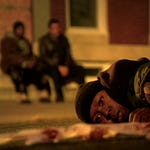We talk about selection games, one of the simplest and most common kind of game: where one party (a person, cat, computer program) is attempting to select from a set of options (what shampoo to buy, which prey to hunt, whether a transaction is fraudulent or not). We analyze a bunch of examples, including another bit of the wire, and talk about the kinds of motivated communication these games create (note that both hosts are 6’ 3”). We also offer a more slowly digestible primer of selection games below:
Selection Games
Imagine that John is selecting among rocks to build a wall. There are certain criteria he uses to make his selection, criteria which involve the rock’s apparent shape, size, and kind. The rock has no perception of John’s selection, nor any interest in whether or not it is selected. It is unable to change itself or its appearance in any way to increase or decrease its chances of selection, even if it were aware of, and interested in, the selection process. There is only a static, one-way perceptual relationship between John and the rock:
Another similar example: John is building a wooden fence. The trees he selects from have some perceptual awareness of whether they have been selected (via being chopped down), and they have an obvious interest in not being selected for fence-building. But the relationship stays simple because a given tree cannot adaptively alter its appearance to John in order to pre-emptively alter his selection choice. If John is searching for maple trees, his objects of selection cannot feign being oak trees.
However, though an individual maple tree lacks the intelligence and bodily agency to adaptively alter its appearance, maple trees in general are governed by evolutionary dynamics which in the long-term simulate intelligent response. John inevitably will use certain markers of mapledom—for instance, the shape of a tree’s leaves, or the patterns on its bark. Maple trees that have irregular leaf shapes will out-survive maple trees with regular leaf shapes, and over sufficient generations, John will be faced with a forest of maples which has functionally countered his selection criteria, none of which possess the marker he used to identify the best trees for his fence. At that point, the relationship can be diagrammed as…
…where the solid gray arrow signifies selection-countering behavior by the tree. Of course, while this is a situation in which (to anthropomorphize evolution) the tree is “trying” to avoid John’s selection, many selection games involve trying to be selected (e.g. for some preferential treatment, as in mating, preservation, workplace promotion, etc). To say that these moves are still “selection-countering” is to illustrate that they are adversarial—that the tree and John have different interests. John, as the selecting party, is (broadly) always interested in discerning the pragmatic truth about his object of selection. He wishes to identify all trees that will work well with his fence-building project, and to avoid wasting time chopping down trees that will work poorly. His interest lies in clarity of vision. The maple tree’s interest, on the other hand—again, to anthropomorphize the evolutionary process, which has no desire per se—is to avoid being chopped down.
We can see this more clearly when we get to full-bodied inter-agent selection games, where the object of selection simultaneously 1) has a stake in being selected, and 2) is able to alter its probability of being selected.
Here, the lion assesses John in a selection game for lunch. He’ll use certain perceptual markers, such as John’s size, physical distance, and gait as proxies to the caloric value of John as a meal, whether John can be easily caught, whether John is healthy, etc. If John is malnourished or injured, it will behoove him to expend energy toward creating the opposite impression—putting on a show of vitality, or feigning aggression, rather than lying weakly in the grasses. John, as a full-bodied agent, is able—unlike the rock or maple tree—to fully play out his side of the selection game: he is perceptually aware of being engaged in a selection game; his is able, roughly, to model the criteria by which selections are made; and he is able to adaptively alter the probability of his being selected or not selected. And, of course, he has an active and non-trivial stake in whether he is selected.
The above diagram, however, is a naive model of how selection games play out. It neglects certain key dynamics, for instance, the lion has some ostensible awareness that John does not wish to be selected, and that John can pick up on the selection game. The lion might not approach John directly but instead sneak up on his flank, precluding John’s ability to counter his selection by preventing John’s awareness of being engaged in a selection game in the first place. In other words, just as an agent who is the object of a selection game is incentivized to strategically alter his appearance to the selector, the selector is incentivized to strategically alter his appearance to the object. Thus:
When these games meet the human social world, they quickly become complex. Frequently, they are not two-player but three-player: whereas, in the examples of the maple tree or the lion, there is a clear, automatically allocated, intrinsic payoff as the result of the selection game—the lion gains a meal; John gains or loses his life—in human social games, a judging party makes a subjective judgment as to the game’s winner, and the allocation of payoffs is the result of social custom rather than “natural” or physical fact. And in these scenarios, naive models of perception and judgment, which fail to acknowledge the recursive, adversarial nature of selection games, fall short of adequately modeling their dynamics.
Here is a naive model of how basketball is played:
The players mutually model one another and strategically preempt one anothers’ moves. If the offensive player in possession of the ball appears to be moving one direction toward the basket, the defending player will attempt to cut off his path. Knowing this, the offensive player may feign left, in order to manipulate his opponent into moving left preemptively, thus clearing a rightward path toward the basket. The defensive player takes this possibility of deception into account by watching the offensive player’s hips (instead of his gaze, shoulders, or ball) for cues to his future path, since there is an inherent physical connection between one’s ability to move and the position of one’s hips which is not astrue of gaze or shoulder position. Meanwhile, a referee observes both players’ actions to determine their legality.
Why this naive model is wrong should be immediately obvious given what we know about the players. They have an active stake in whether a referee interprets (or “selects”) their action as legal or illegal. They have a roughly accurate model of the bases on which selection decisions are made, and the ability to alter the probability of being selected as the fouling or fouled party. Thus, the real game can at least be modeled as:
Here, each player strategically self-represents in order to improve the selection odds in his favor. When an opponent knocks into him, he may exaggerate the contact, falling onto the court or flailing wildly, a practice known as flopping. When he initiates contact with a player, he may attempt to hide it from the referee’s line of sight. We see similar dynamics of strategic self-representation to third-party judges across social selection games, from job applications and college admissions to dating, draft-dodging, and law-breaking.
Insofar as we can simplify the goal of the referee, or the hiring board, or a military doctor, as access to truth—a “clear vision” or accurate assessment relative to their own pragmatic goals, for instance identifying civilians who are mentally and physically sound enough for military duty—then we have to understand the objects of their assessment as constantly seeking to subvert the assessment procedure, either by obscuring vision, or preventing false impressions, etc.
Crucially, this requires a model of the basis on which selection decisions are made. Typically, there are “public” appearances and “private” realities. Whether a recruit is mentally sound, or a candidate fundamentally honest; whether a bright red snake is in fact poisonous; whether a used car is a lemon—these cannot be known with certainty in advance, if at all. Instead, there are certain public markers or measurements—such as John’s gait, to the lion, or a recruit’s heart rate, to the military doctor, which will suggest the more inaccessible—but more important—private quality of “health.” Knowledge of these measures or markers, and the way they are interpreted by the selecting party, is critical in selection objects’ ability to influence selection decisions.
If an evaluator has an active stake in the accuracy of his choice—which may, for instance, be more true of a manager hiring for his own team than a hiring process outsourced to an independent contractor, or a sports referee with tenure—then, as in the case of John and the lion, the selection game becomes properly, mutually adversarial. The savvy evaluator, rather than subscribing to some naive belief in neutral perception, actively disguises or misrepresents his own selection games in order to subvert the evaluated objects’ own attempts at manipulating the selection process:
Unfortunately, a desire—especially among bureaucracies—for decision-making to be ritualized and routine, rather than dynamic, recursive, and adaptive, leads to a simplistic, static attitude toward assessment. Evaluative markers and metrics tend to be generically, naively, and transparently implemented. (I use “metric” to mean any measurement which is used as the basis of selection decisions.) This makes them “gameable.” The gaming of metrics is sometimes referred to as “Goodhart’s Law”—that any measure which becomes a target ceases to be a good measure. And yet, it is precisely our lack of understanding of selection games which leads us to see this dynamic as a conditional law—if a measure becomes a target—rather than an obvious functioning of metrics. That is, any measurement that exerts selection pressure—that is a metric—will be undermined or adversarially manipulated by the objects of selection it seeks to evaluate. This is true even in situations where the objects of selection lack awareness of, and ability to manipulate, the selection game—so long as evolution is present to “counter” metrics and markers at the population level.

















